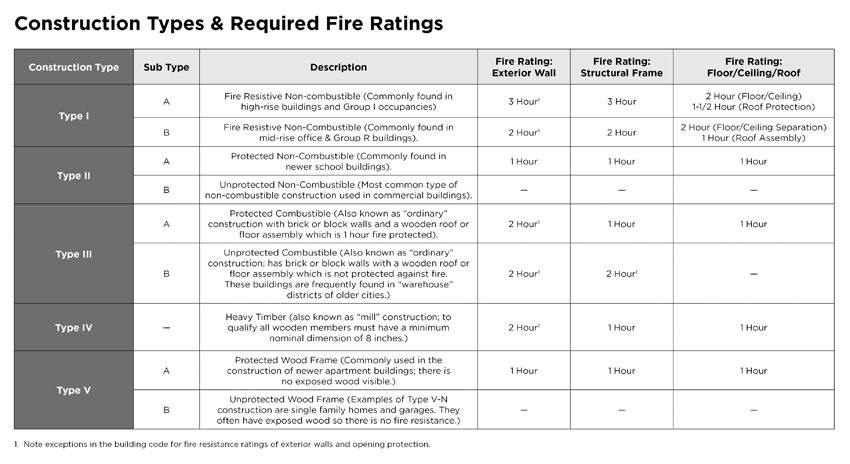Magnesium Oxide (MgO) Floor and Wall Panels for Multifamily Buildings
Fire-Resistance Performance
The excellent fire resistance of high-quality MgO panels deserves some detailed attention, particularly as it relates to their use in multifamily buildings. (Always check to ensure that the manufacturer has completed the required testing.)
The proof of fire resistance for any building product is based on independent testing and verification of results. Some of the most relevant tests and their results for MgO boards are summarized as follows:
- ASTM E136: Standard Test Method for Assessing Combustibility of Materials Using a Vertical Tube Furnace at 750°C is a very focused evaluation of the specimen (piece) material that is carried out under specified laboratory conditions. The test method includes two options, both of which use a furnace to expose test specimens to a temperature of 750 degrees Celsius (1,382 degrees Fahrenheit) for a specified amount of time. The intent behind the test is to determine the combustibility of building materials, not to replicate the conditions of a building that is on fire. As such, at the end of the test, the results are either the material being tested did not combust/catch fire (pass) or it did combust/catch fire (fail) based on one of two possible conditions:
- Condition 1: If weight loss of the test specimen is 50 percent or less: No flaming combustion of the specimen after the first 30 seconds; the recorded temperatures do not at any time rise more than 30°C above the stabilized furnace temperature prior to test commencement.
- Condition 2: If weight loss of the test specimen exceeds 50 percent: No flaming combustion observed throughout the entirety of the test; the recorded temperatures do not at any time rise above the stabilized furnace temperature prior to test commencement.
The building codes rely on the result of this test and will typically classify those materials that pass as “noncombustible” and those that fail as “combustible” (those terms are not used in ASTM E136, only in the codes). Be aware that while MgO itself can meet the noncombustible standard, different manufactured MgO products use a variety of other ingredients that may be combustible. Therefore, if a noncombustible rating is needed in a project (e.g., exterior walls of Type III Construction) then verification will be required from the manufacturer showing that it passed ASTM E136.
- ASTM E84/UL 723: Standard Test Method for Surface Burning Characteristics of Building Materials. Both ASTM and UL use essentially the same test, it is just that UL refers to it by their own number when they are the independent testing laboratory. This is a very common and widely specified test since it is a reliable way to determine building safety in a fire. Specifically, it looks at the way the surface of a material reacts in fire conditions. The concerns are flame spread and the amount of smoke that develops when exposed to a flame. In this laboratory test, a 24-inch by 24-foot sample is placed in a horizontal position with the surface to be evaluated facing downwards. The sample is then exposed to a standard controlled fire, under draft, for 10 minutes.
There are two output measurements that come from this test. The first is the Flame Spread Index which is obtained by measuring the distance that a flame travels along the sample surface and the amount of time that it takes for it to travel. The second is the Smoke Developed Index which is measured by a photo cell that looks at the total smoke developed throughout the test. The data related to both of these are then used to calculate the final test results.
The building codes use the results from the test to then classify materials, such as Class A or Class I ratings, which indicate a maximum flame spread rating of 25, for example. The maximums for smoke developed are based on ratings of 50 Index or 450 Index as determined by the test. If a manufacturer wants to improve its ratings, then it needs to reformulate or otherwise modify the product and have it tested again to show compliance with the desired performance level.
These tests have been applied to MgO boards and the results are, again, impressively positive. Products demonstrated zero flame spread and zero smoke developed putting them at the top of these ratings and classifications for fire safety under the code.
- ASTM E119: Standard Test Methods for Fire Tests of Building Construction and Materials and UL 263: Fire Tests of Building Construction and Materials are two different names for essentially the same test and have been recognized as equal in terms of testing results. They are used to determine fire-resistance ratings expressed in hourly ratings such as 1-hour rated, 2-hour rated, etc. The tests are done on specific assemblies of materials such as wall assemblies, floor/ceiling assemblies, etc. The intent is that the tested assembly contains all of the specific construction components that will be used in the construction of a particular wall or floor/ceiling including framing, (wood or metal), insulation (if any), gypsum board, (for walls or ceilings) underlayment or subfloor (for floors), nails, screws, etc. Since it is easy to imagine many different variations and permutations of these assemblies, it should not be surprising to learn that there are many results from this test. They are also categorized according to ratings for either “load-bearing” or “non-load-bearing” assemblies. Gypsum board companies, for example, are well known for publishing pages of different assemblies and showing the resulting hour rating of those assemblies tested according to ASTM E119/UL 263 and then bearing a specific fire-rated assembly design number and rating. To show code compliance, the actual construction must match exactly the tested assembly without any substitutions or changes.
The test itself is based on an actual full-size specimen of the assembly submitted by manufacturers or others. For wall assemblies, the typical sample size is 10 feet by 10 feet. For floor/ceiling assemblies the typical sample size is 14 feet by 14 feet. The specimen is then exposed to a standard controlled fire (from a furnace) for a specified time period following a time-temperature curve. That means that at different set times during the test, the furnace shall be at different designated temperatures. So, for example, at 5 minutes into the test, the temperature may be specified at 1,000 degrees Fahrenheit; at 10 minutes, 1,300 degrees Fahrenheit; and at 1 hour, 1,700 degrees Fahrenheit; and so forth. If the assembly remains intact as described in the test method at the end of the designated test period, it is rated accordingly (i.e., 1-hour assembly, 11⁄2-hour assembly, 2-hour assembly, etc.).
Following this rigorous testing protocol, MgO board has been found to be very suitable for wall and floor construction when installed in accordance with UL tested and rated assemblies. It has successfully been used to help achieve 1-, 2-, and 3-hour ratings depending on the overall assembly.

MgO can be used to achieve 1-hour and 2-hour fire-rated wall assemblies and has the potential to eliminate additional layers in 2-hour rated wall assemblies. (*Not all MgO panels are manufactured to the same standard. Always consult the manufacturer for product-specific information.)
All of this fire-resistance performance is critical for the safety and welfare not only of multifamily residents and visitors, but also for firefighters and other first responders. Having the ability to incorporate the inate noncombustibility of MgO products that are easy to install helps make the process of building fire-rated assemblies easier and more reliable.









